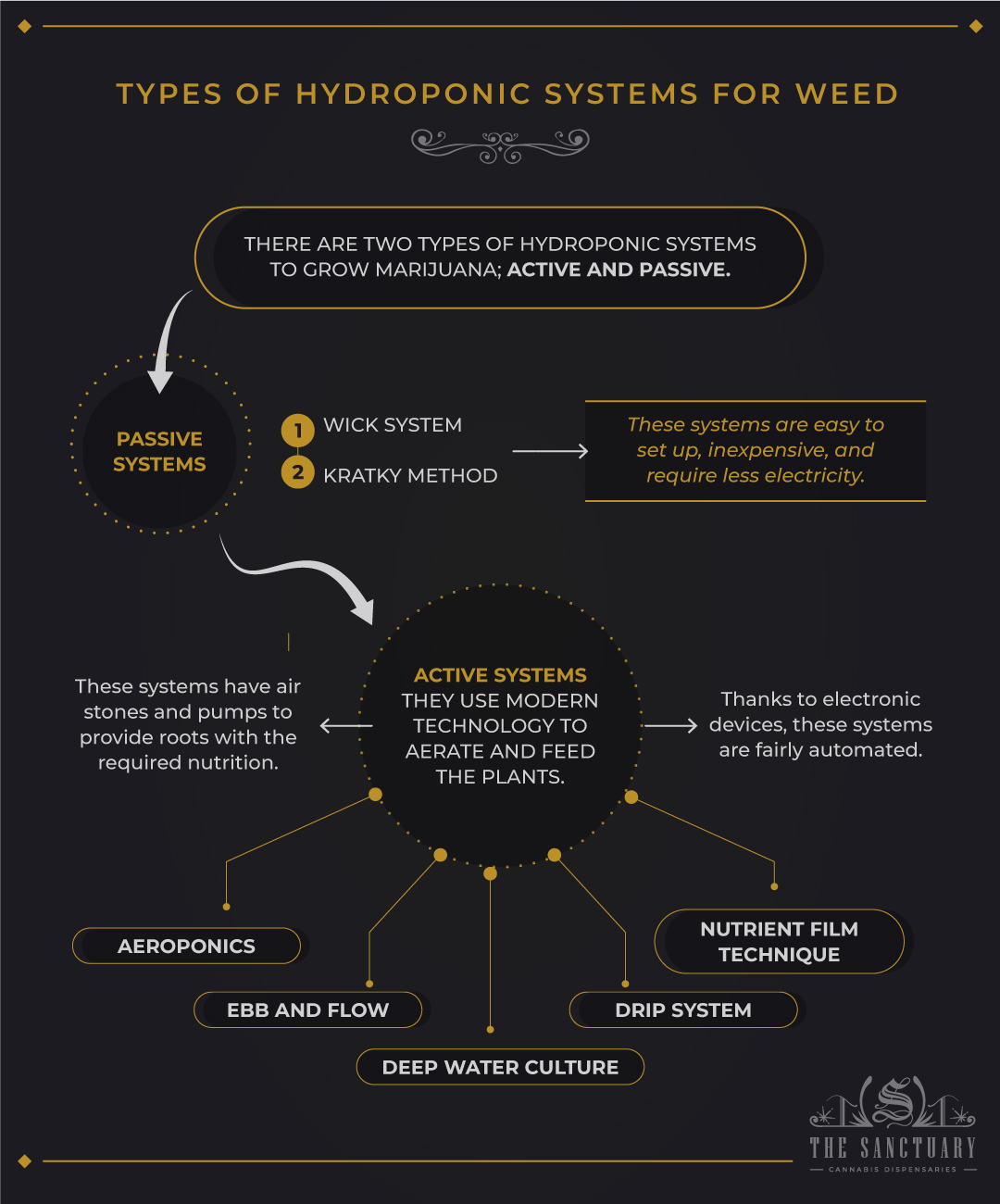Hydroponic farming is a technique in which you grow crops in a water-based solution of nutrients rather than a soil medium. It can include growing media like perlite, coconut coir, or vermiculite.
If you’re a hobbyist, you can grow weed hydroponically. Hydroponic setups allow cannabis to grow faster, especially in the vegetative stages. Weed plants grown hydroponically are also more potent and attract fewer bugs.
So, why not grow weed in water? Let’s learn about growing hydroponic weed.
Types of Hydroponic Systems for Weed

There are two types of hydroponic systems to grow marijuana; active and passive.
Passive systems can further be divided into two methods of hydroponic growth; the Wick System and the Kratky method. These systems are easy to set up, inexpensive, and require less electricity.
Meanwhile, active systems use modern innovative technology to aerate and feed the plants. These systems have air stones and pumps to provide roots with the required nutrition. Thanks to electronic devices, these systems are fairly automated.
Some types of active hydroponic systems include:
- Aeroponics
- Ebb and Flow
- Deep Water Culture
- Drip System
- Nutrient Film Technique
These systems are more expensive but require less manual effort and intervention.
How to Grow Weed in a Hydroponic System?
The first step is to set up a hydroponic system. If you don’t want to spend too much money on a pre-built system, make one of your own.
Materials Required
- Lighting (HPS or LED)
- Grow tent
- Hydroponic reservoir
- Lighting hangars
- Growing medium
- Seeds
- Ventilation fan
- Net mesh planting pots
- Airstone
- Oscillating fan
- pH meter
- Hygrometer
- Hydroponic nutrients
- Carbon filter
Step 1: Select a Growing Medium
The growing medium is the substance in which the roots and stems of your cannabis plants will submerge. From here, the roots will grow into the water for nutrients. Here are some mediums:
- Clay Pebbles: They’re a popular option since they aerate roots. You can get pre-altered pebbles or adjust their pH according to the weed’s needs. Place the pebbles in a plastic hydroponic basket with spaces for root growth.
- Coco Coir: It helps retain moisture and aerate the plant’s roots. The fibers in this growth medium also prevent root infections.
- Rockwool: It allows the upper root system’s hydration. You can put it in a basket like clay pebbles or directly into the tank.
Step 2: Choose the Growing Setup
Now, you must select which of the methods – active or passive – mentioned above you want to use to grow cannabis. For example, a Deep Water Culture system has an air stone for continuous aeration. Meanwhile, plants are placed in net cups.
The Ebb and Flow method allows water to flood the plant growing tray periodically to provide the roots with fresh nutrients and oxygen. Select your desired method based on the materials you will use and the growing environment.
Step 3: Set Up the Grow Lights
The grow lights should be higher than your pots. You can simply hang the lights from the bar or clamp them onto the grow tank.
If you use CFLs, opt for clamp reflectors. There’s no need for electrical work since the socket comes attached.
At a minimum, cannabis plants need 3,000 lumens of light per square foot. Just because a lamp is 3,000 lumens doesn’t mean the plant will get the same amount. Some light is lost due to reflectivity and the distance from the source to the plant.
Ideally, you should get the lighting set up with 7,000 to 10,000 lumens of light per square foot.
Step 4: Adjust the Temperature
The temperature in your grow system should be 80 °F (27 °C) and 85 °F (29 °C). If it’s any higher than that, add some ventilation to remove the additional heat so it doesn’t burn your plant. Add a small heater for a temperature lower than that.
Step 5: Germinate the Weed Seeds
Some cannabis strains grow better in a hydroponic setting than others. Some examples include Blue Dream, OG Kush, Sour Diesel, and Bubba Kush.
First, germinate your seeds using the paper towel method. When the tap root sprouts, transfer the seedlings to blocks of rock wool, which is the perfect medium for early-stage weed plants.
After the plant grows a decent root system, move it to coco coir.
Step 6: Feed Your Plant
Initially, feed your plants with quarter-strength nutrients. Work your way up slowly, increasing the nutrient strength as your plants mature.
There are plenty of hydroponic nutrients available in the market for you to choose from. Follow the instructions on the back of the package to get your mix right.
You must also test your system’s pH level, as it can affect how the nutrients are absorbed. The right pH for cannabis growth is 5.5 to 6.
Step 7: Start the Flowering Stage
Let your cannabis plants grow in the vegetative state until they are 6 to 18 inches tall. The vegetative stage can last anywhere from three to 16 weeks, depending on the strains. During this period, the plant should get six hours of darkness and 18 hours of light.
When the plant is tall enough, start the flowering stage by giving it 12 hours of light and 12 of darkness. The light changes will stimulate bud production.
Step 8: Harvest
Harvest your plants when 75% to 90% of the pistils (whitish hairs in the buds) have turned amber-brown. Or you can tell from the trichomes. When most of them are milky white, it’s time to harvest.
You can trim a few buds at a time or cut down the whole plant at once. Hang the cannabis buds upside down in a dark place to let them dry. The buds have dried completely when they snap off rather than bending when you apply pressure.
Conclusion
Growing cannabis in a hydroponic tank is a bit tricky, but it’s worth the effort. We recommend growing weed in the soil first to get an idea of the plant’s growth trajectory.
Once you’re confident in your farming abilities, make the switch to water-based systems for larger yields and faster harvests.






